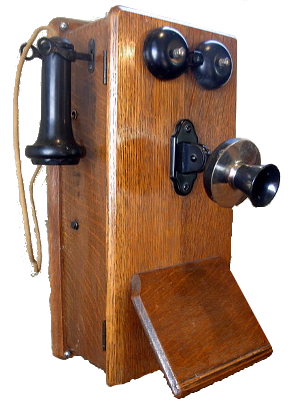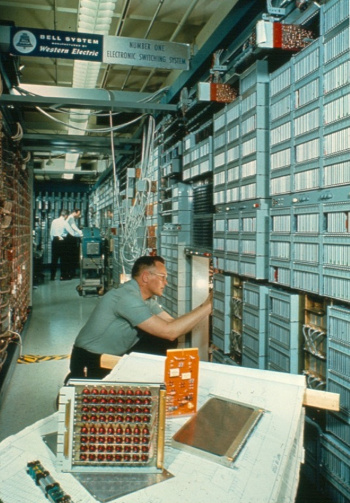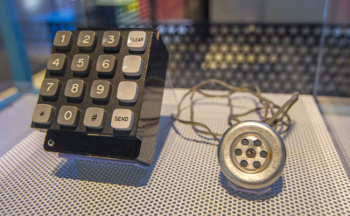The First Electronic Telephone Switching System (1ESS)
May 25, 2015
In the past
decade,
telephone communication has advanced from a point-to-point affair, in which a caller in one place would attempt to contact someone in another place, to a person-to-person affair enabled by
cellphones. Today, more than ninety percent of
American adults own a cellphone, and the number of cellphones is now estimated to exceed the
world population.
Just a decade ago, ninety percent of
US households had a
landline telephone. Since many people now maintain a cellphone as their only telephone, this portion has declined to just fifty percent in those ten years. Telephone communication was a separate
technology for more than a hundred years, but it has now merged in your cellphone with
Internet access and
music/video play through a process of
technological convergence. There's more
computing than
telecommunication in telephones of today.
Cellphone communication is enabled by the multiple, often unsightly,
cellphone towers distributed along our
roadways. Not that the landline telephone didn't come with its associated
artifact, the
telephone pole. However, these poles, more properly called "
utility poles," also carried
electricity to our
homes and
businesses, so the addition of a few more
wires for telephony was never seen as a problem.
The early telephone system was a modern version of the
telegraph in which the "keys" and "sounders" at telegraph station points were replaced by
microphones and
earphones. A telegraph connection was just a long wire connecting two telegraph stations, and these stations could only send messages between their two points, since that's where the wire was. If you wanted to connect to a multitude of stations, as in having a telephone in every house, you needed a multitude of wires.
Of course, it's impractical to have a wire connecting every house to every other house. If you had a thousand houses in a
city, each house would need a wire connected to every one of the other 999 houses to ensure that a call could be placed to those houses. Not only that, but the
homeowner himself would need to connect his telephone to the appropriate wire to reach the desired party. The telephone system has a different "
network topology" in which a wire pair from each home connects it to a
central office. In that central office, a
telephone operator would connect the caller's wire to the wire of the desired call recipient.
A telephone operator might be able to handle connections between several hundred houses, but things get out of hand when thousands are involved. When a call had to connect from one group of a few hundred to someone outside the group, the operator would instead connect the call to the operator in charge of a different group of which the intended recipient was a part. In this way, a city with several thousand homes could easily have a universal telephone system with a few tens of operators.
Calling outside a local area - that is,
long distance calling - could operate in the same manner, except for the fact that your
voice over those longer wires would become a
whisper after ten
miles. The problem of long distance voice signaling was solved by inserting
amplifiers at points along these long wires. In the first half of the
20th century, these amplifiers were built from
vacuum tubes. These vacuum tube amplifiers required a lot of
power, they generated a lot of
heat, and they were expensive to build and maintain. When
transistors replaced vacuum tubes at the end of the 20th century, long distance calling became less expensive.
The loss of jobs to
automation is not just a recent effect. At the turn of the 20th century, scores of (mostly)
young women were employed as
telephone switchboard operators. They were essential to telephone communication, since early telephones didn't have
number dials, and the only way that your call could be connected to another telephone is to have your telephone wires manually connected to others. Eventually, the function of telephone operators was replaced through automation. The number of telephone switchboard operators in the United States peaked in the 1930s at about a quarter million.[1] Today, there are only about 10,000 telephone operators in the US, few of whom are responsible for connecting calls.[1]

"Look, Ma, no dial!"
Dials were absent from the earliest telephones, since all calls were connected by a human operator. It's interesting to note that telephones without dials and keypads can now be used to place calls without operators through speech recognition technology.
An antique wood case telephone in New Ulm, Minnesota.
(Photo by Jonathunder, via Wikimedia Commons.)
Automation in the early 20th century, long before the
invention of the
transistor, was accomplished using
electromagnetic relays. These relays were
rotary devices in which electrical connections were made by rotating an
armature to a specific location. These relays would step from place-to-place in
synchrony with the
pulse signal generated by the telephone dial. In that way, the dialed numbers could be decoded into the proper electrical connections.
Electromagnetic relays, as all
mechanical components, will fail after too many operations. The relay-switched telephone network had the additional problem that it was slow. The dials on telephones moved slowly, since their pulses couldn't outrun the speed of the relays. Both subscribers and the telephone company had an interest in a better switching technology. It's not a coincidence that the transistor was invented at a telephone company
research center,
Bell Laboratories, since better means of switching telephone signals was a goal of telephone research.
The transistor enabled not only amplifiers for long distance calling and improved switching, but also computing. By the
1960s, it had become practical to use computers to enhance telephone switching. The first computerized
electronic switching system, called a
stored program control telephone exchange, was put into service in
Succasunna, New Jersey, in 1965. A
dedication ceremony was held on May 27, 1965, and the exchange, serving 4,000 customers, began service on May 30, 1965.[3] Miniature magnetic reed switches replaced the bulky electromechanical relays of older telephone exchanges. The exchange was called the "Number One Electronic Switching System," abbreviated as 1ESS. 1ESS was designed for a peak capacity of 37,000-80,000 calls per hour, depending on the hardware configuration.
Circuit boards containing 64
magnetic reed relays arranged in an 8x8
matrix acted as a smaller, automated version of a telephone operator's
plug board. Computers in the mid-1960s were primitive by today's standards. The computer of the 1ESS operated at a
clock rate of about 200
kilohertz, which is 10,000 slower than a typical
desktop computer of today. The
computer memory was likewise limited. The
program memory - the memory dedicated to the
operating instructions for the exchange - was contained on 2048
circuit cards that provided 731,000
bytes of memory, just under a
megabyte. This is 2,000 smaller than the memory capacity of a cellphone.
This program memory was unlike the
semiconductor memory of today. It was a
magnetic memory type known as
permanent magnet twistor in which
digital data were stored in magnetized regions of a
metal tape (
Vicalloy). Twistor memory was invented at Bell Labs in 1957, but the technology was soon replaced by semiconductor memory a few years after 1ESS was operational. The 1ESS system had a further working memory composed of
ferrite cores, in common use at the time, to store data such as called telephone numbers. The core memory system had 8,000
words of 24 bit length.

New Jersey Bell Switchman, Fritz Blume, checks a circuit at the 1ESS office in Succasunna, New Jersey.
In the foreground are some of the basic units of this electronic telephone switching system.
(Photograph courtesy of Alcatel-Lucent Bell Laboratories)
The impetus for development of this telephone exchange was not just the enhanced
reliability that these new technologies offered. 1ESS also made possible telephone enhancements that are now common, such as
call waiting and
three-way calling. It also allowed
companies to have their own
centralized telephone exchange without needing equipment located at the company site.
This introduction of a computerized telephone network brought with it the first group of
computer hackers, known as "
phone phreaks." Telephone
engineers decided to use
tones, similar to
keypad touch-tones, to send
network commands along the same wires used for transmitting voice signals.
specifications for these tone commands were discovered by
electronics hobbyists who used them to make free long distance calls. One phone phreak, known as "
Captain Crunch," was renowned as using a
cereal box toy whistle as a source of command tones.
Eventually, hobbyists constructed electronic boxes to precisely generate these "in-band" tones. These "
blue boxes" became such a problem that the telephone company revised their telephone switches to send commands as "out-of-band" signals that could not be generated at a consumer telephone. Many of the phone phreaks went on to participate in early
personal computer culture, such as the
Silicon Valley based
Homebrew Computer Club. Members of that club started the earliest personal computer companies, including
Apple Computer.

A Blue Box.
The speaker element was used to acoustically couple tones into a telephone handset.
(Photograph by Maksym Kozlenko, via Wikimedia Commons.)
In 1976, improvements were made to existing 1ESS central office switches. The upgraded version, called 1AESS had a processor with a four-fold faster speed and
computer disk storage, all in a quarter of the original
volume. Thousands of 1ESS and 1AESS systems were deployed, but most were replaced in the
1990s by more advanced central office switches. A few 1AESS systems still remain, most of which are located in the
Atlanta, Georgia, metropolitan area, the
Saint Louis, Missouri metropolitan area, and in the
Dallas/Fort Worth, Texas metropolitan area.

Yesterday and today. The building at 144 Route 10 West, Succasunna, New Jersey, housing the No. 1 ESS, as it appeared in 1965 (left), and as it appears today, as a Verizon facility (right). (Left photograph courtesy of Alcatel-Lucent Bell Laboratories; right photograph by the author. Click for larger image.)
References:
- Janet M. Hooks, "Women's Occupations Through Seven Decades," Women's Bureau Bulletin No. 218, United States Department of Labor, June 9, 1947
- Occupational Employment and Wages, 43-2021 Telephone Operators, United States Department of Labor, Bureau of Labor Statistics, May 2013
- G.E. Schindler, Jr., Editor, "A History of Engineering and Science in the Bell System: Switching Technology (1925-1975), Bell Telephone Laboratories, Inc. 1982.
Permanent Link to this article
Linked Keywords: Decade; telephone; communication; mobile phone; cellphone; American; adult; world population; United States; US; household; landline telephone; technology; Internet; portable media player; music/video player; technological convergence; computing; telecommunication; cell site; cellphone tower; road; roadway; cultural artifact; telephone pole; utility pole; electricity; home; business; wire; electrical telegraph; microphone; headphones; earphone; city; owner-occupier; homeowner; network topology; telephone exchange; central office; telephone operator; long distance calling; voice; whisper; mile; amplifier; 20th century; vacuum tube; electric power; heat; transistor; automation; young women; telephone switchboard operator; rotary dial; number dial; keypad; speech recognition; antique; wood; New Ulm, Minnesota; Wikimedia Commons; invention; electromagnet; electromagnetic; relay; rotary system; rotary device; armature; synchronization; synchrony; pulse signal; machine; mechanical; research center; Bell Labs; Bell Laboratories; 1960s; electronic switching system; stored program control; telephone exchange; Succasunna, New Jersey; grand opening; dedication ceremony; reed switch; magnetic reed relay; matrix; telephone switchboard; plug board; clock rate; kilohertz; desktop computer; computer memory; read-only memory; program memory; software; operating instructions; printed circuit board; circuit card; bytes; megabyte; semiconductor memory; magnetic domain; permanent magnet; twistor memory; digital data; metal; Vicalloy; ferrite core memory; word - computer architecture; New Jersey Bell; Alcatel-Lucent; reliability; call waiting; conference call; three-way calling; company; Centrex; centralized telephone exchange; computer hacker; phreaking; phone phreak; electrical engineering; engineer; tone; dual-tone multi-frequency signaling; keypad touch-tones; public switched telephone network; PSTN; command; specification; electronics; hobbyist; John Draper; Captain Crunch; cereal box prize; cereal box toy; whistle; blue box; personal computer; culture; Silicon Valley; Homebrew Computer Club; Apple Inc.; Apple Computer; loudspeaker; speaker element; acoustics; acoustically; telephone handset; computer disk storage; volume; 1990s; Atlanta, Georgia, metropolitan area; Saint Louis, Missouri metropolitan area; Dallas/Fort Worth, Texas metropolitan area; 1ESS building.